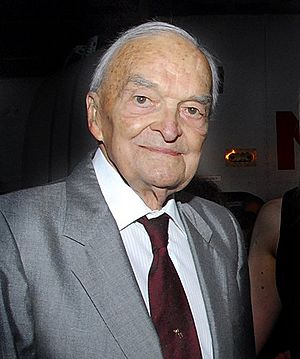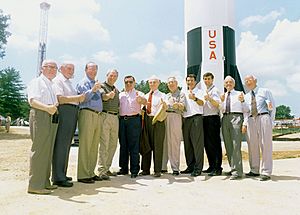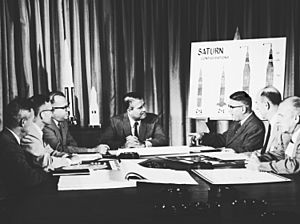Walter Haeussermann facts for kids
Quick facts for kids
Walter Haeussermann
|
|
|---|---|

Haeussermann in 2008
|
|
| Born | March 2, 1914 Künzelsau, Kingdom of Württemberg, German Empire
|
| Died | December 8, 2010 (aged 96) Huntsville, Alabama, U.S.
|
| Nationality | German, United States |
| Alma mater | Darmstadt University of Technology |
| Awards | Department of the Army Decoration for Exceptional Civilian Service, 1959 NASA Outstanding Leadership Medal, 1963 NASA Exceptional Service Medal, 1969 Institute of Navigation Superior Achievement Award, 1969 |
| Scientific career | |
| Fields | Mathematics, Engineering |
| Institutions | Peenemünde Redstone Arsenal Marshall Space Flight Center |
Walter Haeussermann (pronounced Hoy-ser-man) was a brilliant German-American engineer. He was a key member of the famous "von Braun rocket group." This team helped design and build some of the most important rockets for both Germany and the United States. Walter worked on guiding rockets, making sure they flew exactly where they needed to go. He was a leader in the guidance and control laboratory at the Marshall Space Flight Center. He received a special award in 1959 for his important work on the U.S. rocket program.
Contents
Walter Haeussermann's Early Life and Rocket Work
Walter Haeussermann was born in Germany in 1914. This was just before the start of World War I. He later went to the Darmstadt University of Technology. There, he earned a special degree called a doctorate in physics.
During World War II, he joined the German army. On December 1, 1939, he was sent to a secret rocket development center. This place was called Peenemünde. He remembered seeing a rocket engine test on his very first day. He said he was "astonished" that such a thing already existed. He also met the famous rocket scientist Wernher von Braun very soon after arriving. Walter worked on the V-2 rocket. He helped design its guidance system. This system used early computers to control the rocket's flight.
He worked at Peenemünde for three years. Then, he went back to Darmstadt. There, he helped develop a special guidance platform using gyroscopes.
Moving to the United States
After the war, Walter was invited to join von Braun's team in the United States. They were at Fort Bliss, Texas. At first, Walter could not go because his wife was sick. Other scientists, like Helmut Hölzer and Ernst Steinhoff, did accept the invitation. They came to the U.S. in 1945. They stayed in touch with Walter.
Walter finally came to the United States in 1947. He rejoined von Braun's team. He continued his work on guiding and controlling rockets. In 1951, the group moved to Redstone Arsenal.
In 1954, Walter Haeussermann became a U.S. citizen. At that time, he was a director at what is now the Marshall Space Flight Center. He led the team that worked on rocket guidance and control.
Working with NASA and the Saturn V
NASA was created in 1958. Walter Haeussermann was one of the first people to join. At NASA, he was in charge of the electrical and computer systems. He also led the guidance and navigation systems for the huge Saturn V rocket. This rocket was used to send astronauts to the Moon.
Walter took his job very seriously. He wanted to make sure the astronauts were safe. He once said that he would not accept any congratulations until the Apollo 11 astronauts were safely back on Earth. He was very proud when they returned.
In 1959, he received a special award. It was called the Department of the Army Decoration for Exceptional Civilian Service. This award recognized his important work for the U.S. space program.

Walter Haeussermann loved the space program his whole life. He often went to special events and reunions until he passed away in 2010.
How Walter Haeussermann Helped Guide Rockets
Walter Haeussermann's main job was to create systems that could automatically guide and control missiles. He was very important in designing the guidance system for the powerful Saturn V rocket.
He also did other research. For example, he studied how to control a spacecraft's direction in three ways. He also looked into using special devices called Hall devices in aerospace control. Later in his career, he worked on control issues for experiments on board the Space Shuttle.


